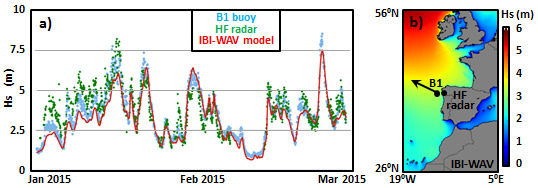Extreme Wave Height Events in NW Spain: A Combined Multi-Sensor and Model Approach
Abstract
:1. Introduction
2. Materials and Methods
2.1. The Iberia-Biscay-Ireland Wave (IBI-WAV) Operational Forecasting System
2.2. In Situ Observations
2.3. HF Radar (HFR)
2.4. Satellite Data
3. Results
3.1. Preliminary Skill Assessment of HF Radar Wave Height Estimations
3.2. Analysis of Extreme Wave Height Events in Galicia (2015–2016)
3.3. Use of Satellite-Sensed and IBI-WAV Hs Estimations to Analyze the Impact of Storm Ophelia (October 2017)
4. Discussion
5. Conclusions
Acknowledgments
Author Contributions
Conflicts of Interest
References
- Gleizon, P.; Campuzano, F.; Carracedo, P.; Martinez, A.; Goggins, A.; Atan, R.; Nash, S. Wave energy resources Along the European coast. In Marine Renawable Energies; Springer: Cham, Switzerland, 2017; pp. 37–69. ISBN 978-3-319-53536-4. [Google Scholar]
- Iglesias, G.; López, M.; Carballo, R.; Castro, A.; Fraguela, J.A.; Frigaard, P. Wave energy potential in Galicia (NW Spain). Renew. Energy 2009, 34, 2323–2333. [Google Scholar] [CrossRef]
- Sembiring, L.; Van Ormondt, M.; Van Dongeren, A.; Roelvink, D. A validation of an operational wave and surge prediction system for the Dutch coast. Nat. Hazards Earth Syst. Sci. 2015, 15, 1231–1242. [Google Scholar] [CrossRef]
- Carraccedo, G.P.; Balseiro, C.F.; Penabad, E.; Gómez, B.; Pérez-Muñuzuri, V. One Year Validation of Wave Forecasting at Galician Coast. J. Atmos. Ocean Sci. 2005, 10, 407–419. [Google Scholar] [CrossRef]
- Bell, R.J.; Gray, S.L.; Jones, O.P. North Atlantic storm driving of extreme wave heights in the North Sea. J. Geophys. Res. Oceans 2017, 122, 3253–3268. [Google Scholar] [CrossRef]
- Guimaraes, P.V.; Farina, L.; Toldo, E.E., Jr. Analysis of extreme wave events on the southern coast of Brazil. Nat. Hazards Earth Syst. Sci. 2014, 14, 3195–3205. [Google Scholar] [CrossRef]
- Atan, R.; Goggins, J.; Harnett, M.; Nash, S.; Agostinho, P. Assessment of extreme wave height events in Galway Bay using High Frequency radar (CODAR) data. In Renewable Energies Offshore; CRC Press: Boca Raton, FL, USA, 2015; pp. 49–56. [Google Scholar]
- Atan, R.; Goggins, J.; Harnett, M.; Agostinho, P.; Nash, S. Assessment of wave characteristics and resource variability at a ¼-scale wave energy test site in Galwat Bay using waverider and high frequency radar (CODAR) data. Ocean Eng. 2016, 117, 272–291. [Google Scholar] [CrossRef]
- Ardhuin, F.; Rogers, E.; Babanin, A.; Filipot, J.-F.; Magne, R.; Roland, A.; Van der Westhuysen, A.; Queffeulou, P.; Lefevre, J.-M.; Aouf, L.; Collard, F. Semi empirical dissipation source functions for wind-wave models: Part I, definition and calibration and validation. J. Phys. Oceanogr. 2010, 40, 1917–1941. [Google Scholar] [CrossRef]
- Janssen, P.; Aouf, L.; Behrens, A.; Korres, G.; Cavalieri, L.; Christiensen, K.; Breivik, O. Final Report of Work-Package I of FP7 Research Project MyWave Project; European Commission: Brussels, Belgium, 2014. [Google Scholar]
- Aouf, L.; Toledano, C.; Amo-Baladrón, A.; Renaud, R.; Sotillo, M.G. Product User Manual for Atlantic—Iberian Biscay Irish—Wave Analysis and Forecast Product: IBI_ANALYSIS_FORECAST_WAV_005_005. 2017, pp. 1–38. Available online: http://marine.copernicus.eu/documents/PUM/CMEMS-IBI-PUM-005-005.pdf (accessed on 31 March 2017).
- Sotillo, M.G.; Aouf, L.; Alfonso, M.; Renaud, R.; Toledano, C.; Lorente, P.; Dalphinet, A. Quality Information Document for Atlantic—Iberian Biscay Irish—Wave Analysis and Forecast Product. 2017, pp. 1–38. Available online: http://marine.copernicus.eu/documents/QUID/CMEMS-IBI-QUID-005-005.pdf (accessed on 31 March 2017).
- Copernicus Marine In situ Team. Copernicus In Situ TAC, Real Time Quality Control for WAVES; Copernicus in situ TAC: Toulouse, France, 2017; pp. 1–19. [Google Scholar] [CrossRef]
- Crombie, D.D. Doppler spectrum of sea echo at 13.56 Mc/s. Nature 1955, 175, 681–682. [Google Scholar] [CrossRef]
- Lipa, B.J.; Nyden, B. Directional wave information from the SeaSonde. IEEE J. Ocean. Eng. 2005, 30, 221–231. [Google Scholar] [CrossRef]
- López, G.; Conley, D.; Greaves, D. Calibration, validation and analysis of an empirical algorithm for the retrival of wave spectra from HF radar sea echo. J. Atmos. Ocean. Technol. 2016, 33, 245–261. [Google Scholar] [CrossRef]
- Long, R.M.; Barrick, D.; Largier, J.L.; Garfield, N. Wave observations from Central California: SeaSonde Systems and in situ wave measurements. J. Sens. 2011, 1–18. [Google Scholar] [CrossRef]
- Lipa, B.; Barrick, D.; Alonso-Martirena, A.; Fernandes, M.; Ferrer, M.; Nyden, B. Brahan project high frequency radar ocean measurements: currents, winds, waves and their interactions. Remote Sens. 2014, 6, 12094–12117. [Google Scholar] [CrossRef]
- Sterl, A.; Caires, S. Climatology, variability and extrema of ocean waves: Web-based KNMI/ERA-40 wave atlas. Int. J. Climatol. 2005, 25, 963–977. [Google Scholar] [CrossRef]
- Wyatt, L.R.; Green, J.J.; Gurgel, K.W.; Nieto Borge, J.C.; Reichert, K.; Hessner, K.; Günther, H.; Rosenthal, W.; Saetra, O.; Reistad, M. Validation and intercomparison of wave measurements and models during the EuroROSE experiments. Coast. Eng. 2003, 48, 1–28. [Google Scholar] [CrossRef]
- Wyatt, L.R.; Thompson, S.P.; Burton, R.R. Evaluation of high frequency radar wave measurements. Coast. Eng. 1999, 37, 259–282. [Google Scholar] [CrossRef]
- Falco, P.; Buonocore, B.; Cianelli, D.; De Luca, L.; Giordano, A.; Iermano, I.; Kalampokis, A.; Saviano, S.; Uttieri, M.; Zambardino, G.; et al. Dynamics and sea state in the Gulf of Naples: Potential use of high-frequency radar data in an operational oceanographic context. J. Oper. Oceanogr. 2016, 9, 33–45. [Google Scholar] [CrossRef]
- Hisaki, Y. Inter-comparison of wave data obtained from single high-frequency radar, in situ observation and model prediction. Int. J. Remote Sens. 2014, 35, 3459–3481. [Google Scholar] [CrossRef]
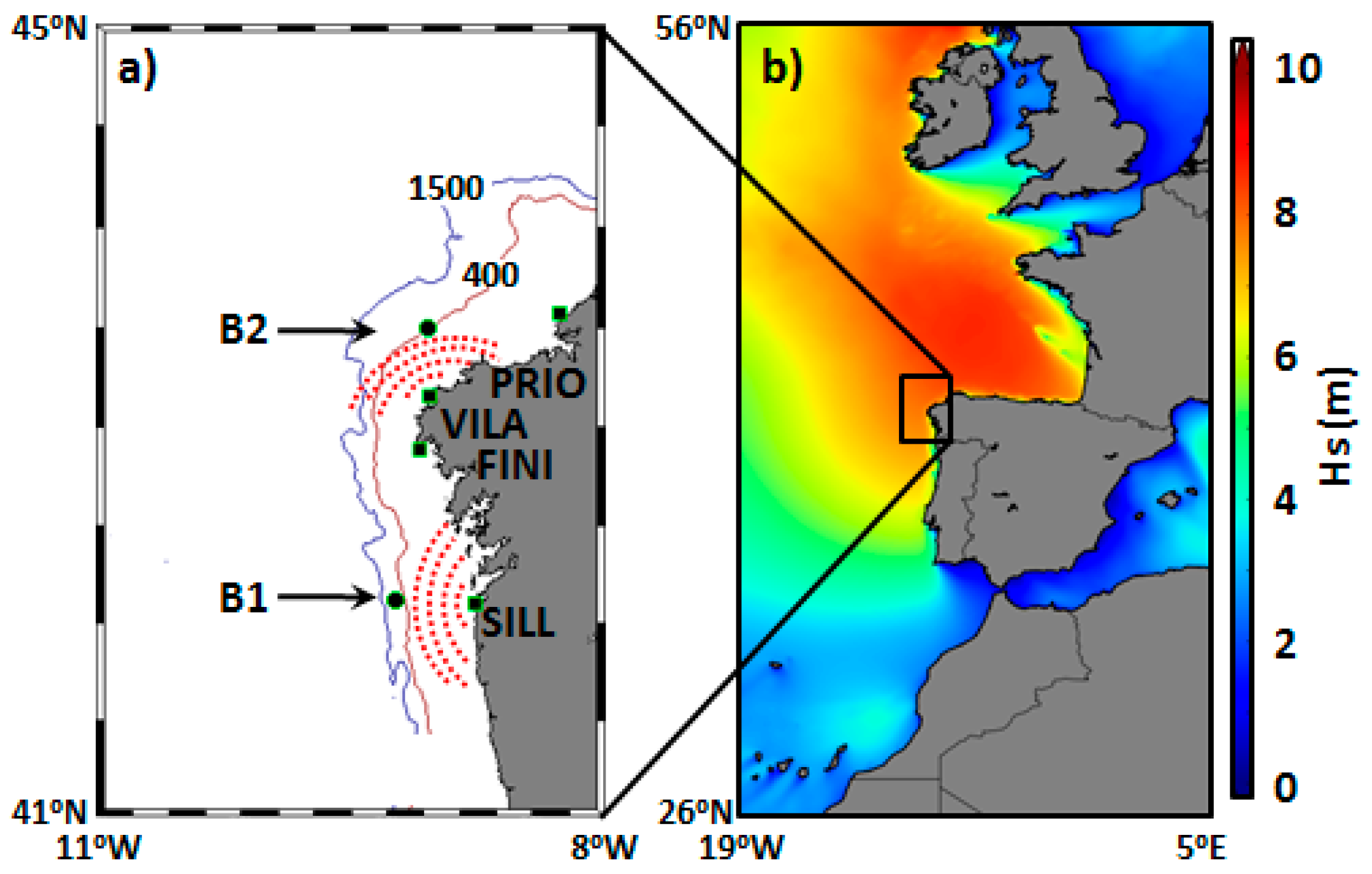
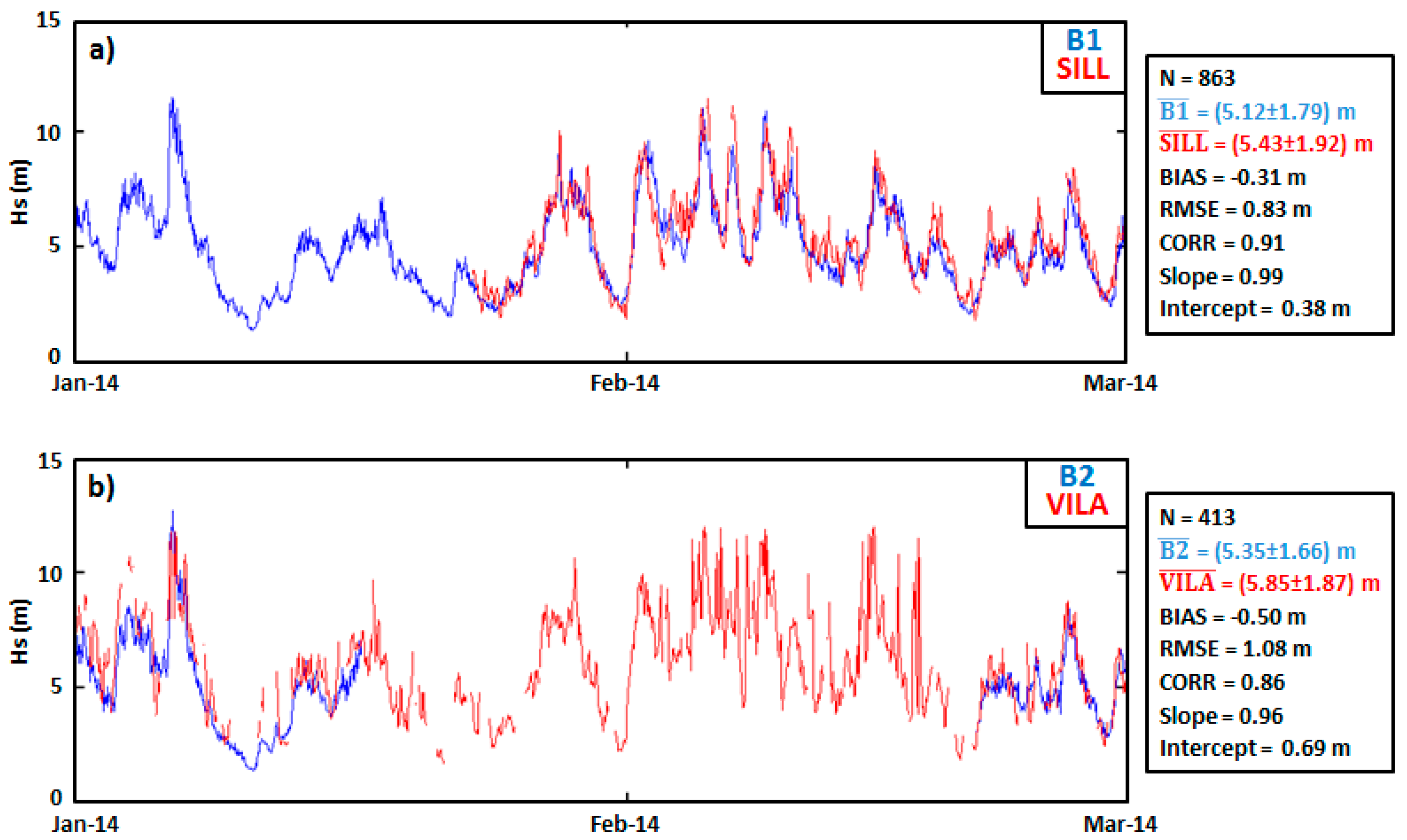
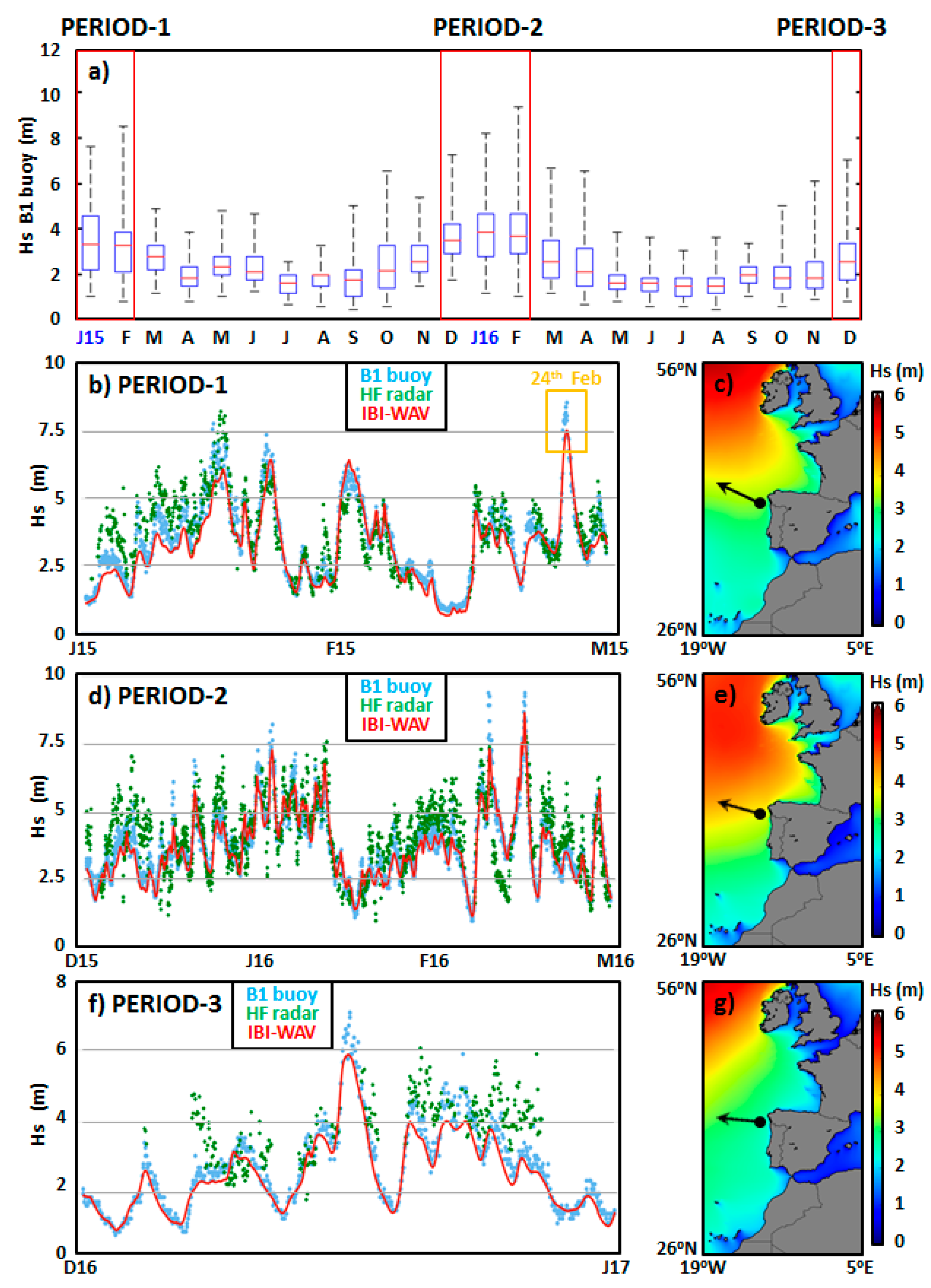
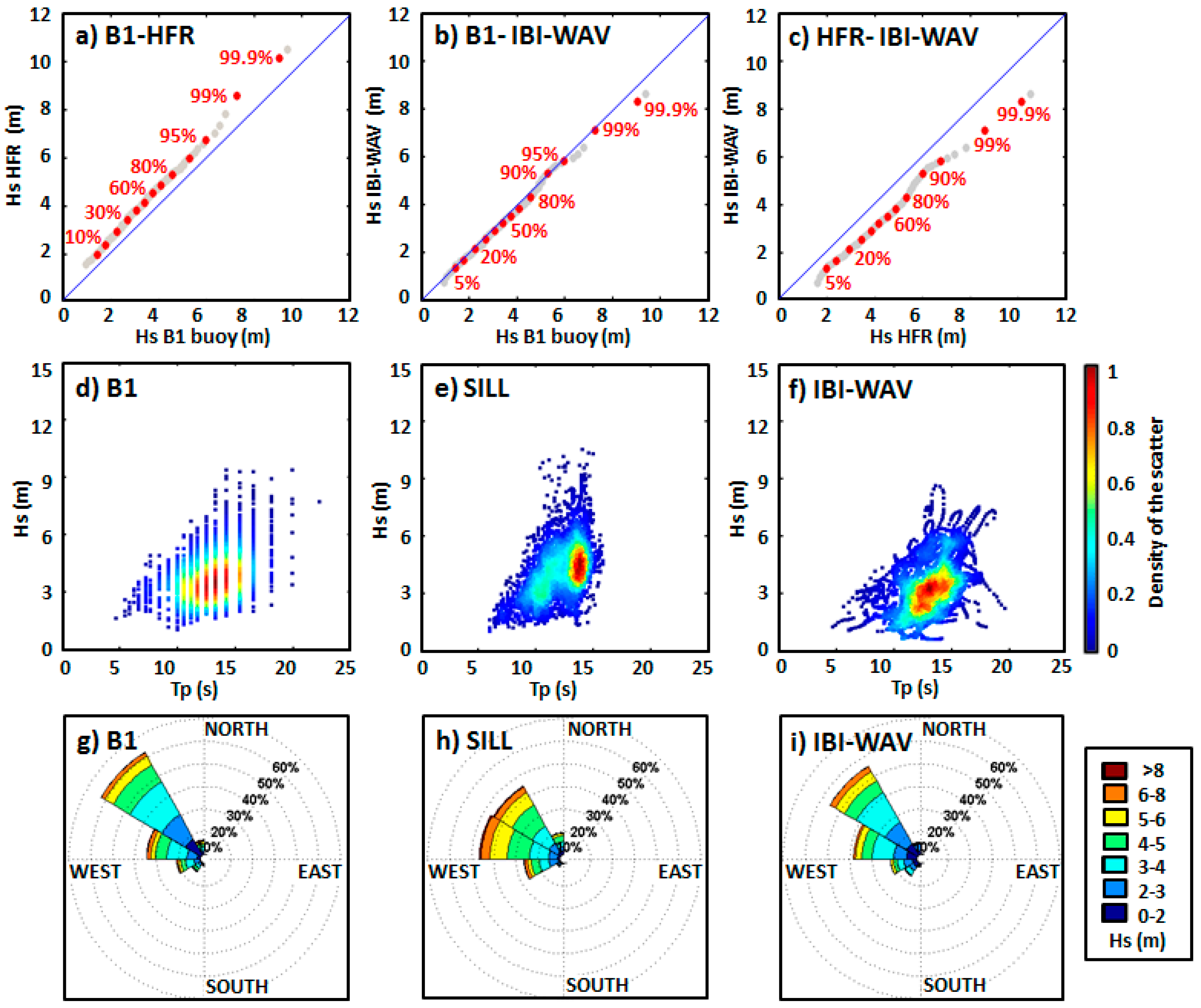
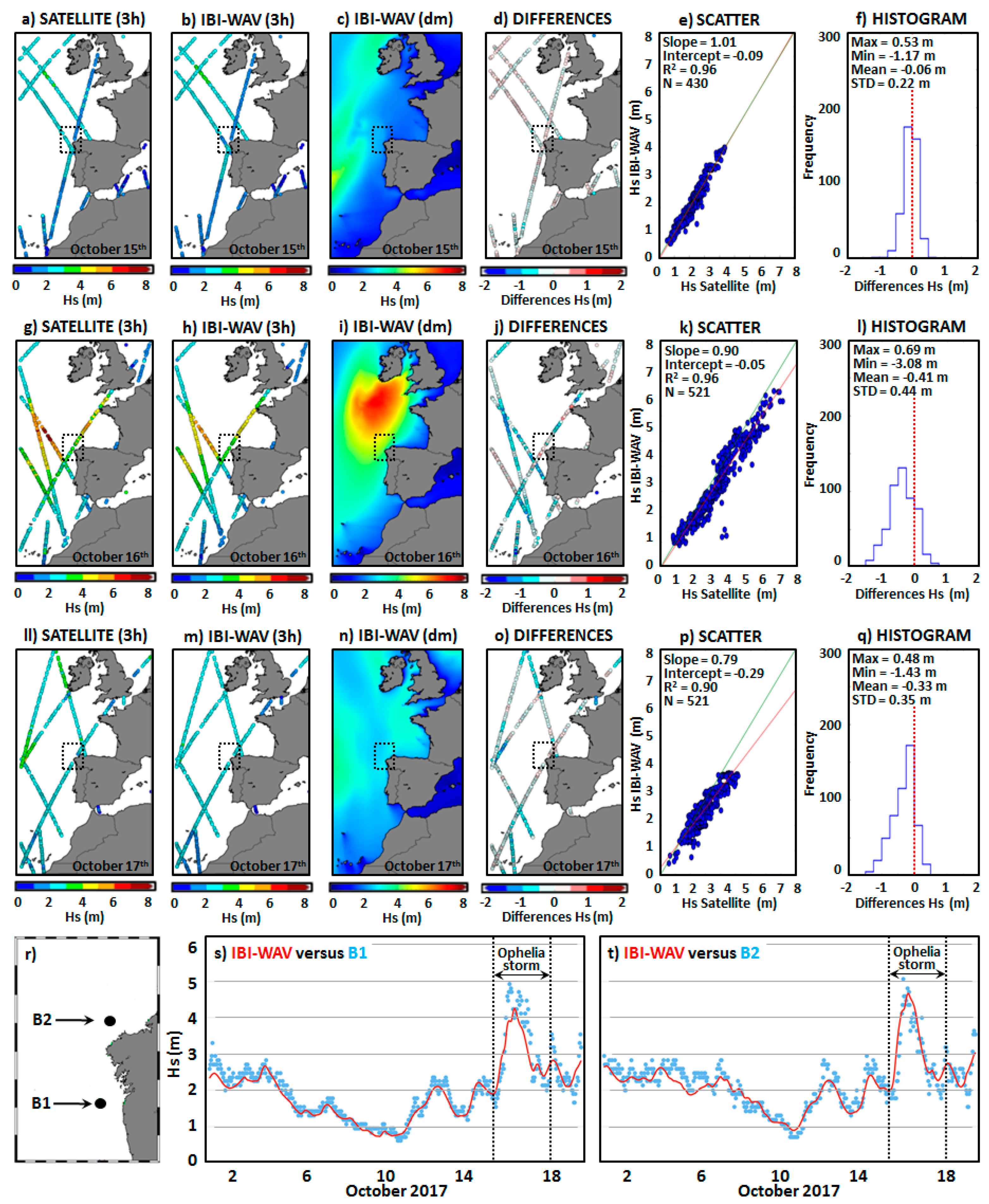
| Metrics | Period 1 (2 Months) | Period 2 (3 Months) | Period 3 (1 Month) | |||
|---|---|---|---|---|---|---|
| IBI-WAV Versus… | B1 | HFR | B1 | HFR | B1 | HFR |
| Hourly data | 1416 | 1113 | 2184 | 1904 | 744 | 390 |
| Bias (m) | −0.20 | −0.44 | −0.13 | −0.39 | −0.19 | −0.96 |
| RMSE (m) | 0.47 | 1.06 | 0.41 | 1.09 | 0.38 | 1.03 |
| CORR | 0.96 | 0.74 | 0.95 | 0.73 | 0.97 | 0.75 |
| Hs | Period 1 (2 Months) | Period 2 (3 Months) | Period 3 (1 Month) | ||||||
|---|---|---|---|---|---|---|---|---|---|
| Source | B1 | HFR | IBIW | B1 | HFR | IBIW | B1 | HFR | IBIW |
| Hourly data | 1416 | 1113 | 1416 | 2184 | 1904 | 2184 | 744 | 390 | 744 |
| Mean (m) | 3.34 | 3.99 | 3.13 | 3.83 | 4.27 | 3.70 | 2.71 | 4.19 | 2.52 |
| Std (m) | 1.47 | 1.37 | 1.43 | 1.29 | 1.46 | 1.25 | 1.19 | 1.15 | 1.04 |
| Maximum (m) | 8.55 | 8.5 | 7.51 | 9.38 | 9.83 | 8.64 | 7.03 | 6.02 | 5.86 |
| High (P90) (m) | 5.39 | 5.66 | 5.33 | 5.51 | 6.12 | 5.48 | 4.34 | 5.46 | 3.85 |
| N Events P90 | 118 | 98 | 128 | 178 | 171 | 196 | 65 | 35 | 67 |
| Extreme (P99) | 7.27 | 7.96 | 6.89 | 7.69 | 8.35 | 7.25 | 6.33 | 8.04 | 5.79 |
| N Events P99 | 13 | 11 | 14 | 22 | 19 | 21 | 6 | 4 | 7 |
© 2017 by the authors. Licensee MDPI, Basel, Switzerland. This article is an open access article distributed under the terms and conditions of the Creative Commons Attribution (CC BY) license (http://creativecommons.org/licenses/by/4.0/).
Share and Cite
Lorente, P.; Sotillo, M.G.; Aouf, L.; Amo-Baladrón, A.; Barrera, E.; Dalphinet, A.; Toledano, C.; Rainaud, R.; De Alfonso, M.; Piedracoba, S.; et al. Extreme Wave Height Events in NW Spain: A Combined Multi-Sensor and Model Approach. Remote Sens. 2018, 10, 1. https://doi.org/10.3390/rs10010001
Lorente P, Sotillo MG, Aouf L, Amo-Baladrón A, Barrera E, Dalphinet A, Toledano C, Rainaud R, De Alfonso M, Piedracoba S, et al. Extreme Wave Height Events in NW Spain: A Combined Multi-Sensor and Model Approach. Remote Sensing. 2018; 10(1):1. https://doi.org/10.3390/rs10010001
Chicago/Turabian StyleLorente, Pablo, Marcos G. Sotillo, Lotfi Aouf, Arancha Amo-Baladrón, Ernesto Barrera, Alice Dalphinet, Cristina Toledano, Romain Rainaud, Marta De Alfonso, Silvia Piedracoba, and et al. 2018. "Extreme Wave Height Events in NW Spain: A Combined Multi-Sensor and Model Approach" Remote Sensing 10, no. 1: 1. https://doi.org/10.3390/rs10010001



